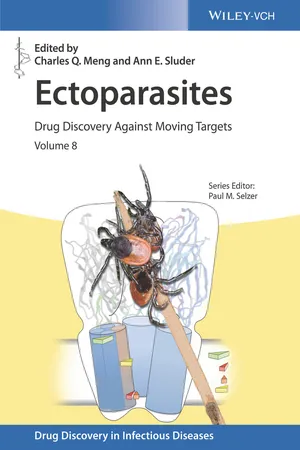Introduction
The Merriam Webster dictionary defines a parasite as an organism living in, with, or on another organism. “Parasitism” refers to the intimate association between the parasite and host, whereby the parasite obtains part or all of its nutrition or needs from the host and results in an overall negative effect on the host. Simply, ectoparasites live on the outside of the animal and endoparasites on the inside. Microparasites (bacteria, viruses, protozoa) establish infections where it is hard to quantify numbers of infectious agents present, so numbers of infected hosts are quantified, rather than numbers of parasites within each host. Microparasites are small and have rapid generation times relative to their hosts. Macroparasites (nematodes, flies, ticks, etc.) are larger and can be counted; so the unit of study is the individual parasite, not the infected host. Macroparasites are also small and have rapid generation times, but there is less of a difference than between microparasites and host. Epiparasites are an interesting class of parasites whereby a parasite parasitizes a parasite in a host–parasite interaction referred to as hyperparasitism (as referred to in the well‐known poem by Jonathan Swift: “a flea has smaller fleas that on him prey, And these have smaller still to bite ’em: And so proceed ad infinitum”). Examples of this are the larvae of the tapeworm, Dipylidium caninum, which infect fleas (Ctenocephalides species) and biting lice (Trichodectes canis). When a dog ingests a parasitized flea/louse when grooming, the tapeworm develops into an adult in the dog’s intestine.
Fleas, ticks, and flies are the most visible and treated ectoparasites, but lice and mites also affect health and wellness. Infestation with ectoparasites causes many pathogenic effects, including tissue damage and blood loss due to feeding; hypersensitivity responses following exposure to ectoparasite antigens; secondary infections; and, most importantly disease transmission. Ectoparasites have evolved to fill many niches, but may be considered in terms of their host association. Many mites and lice live almost completely in permanent association with their host and, as such, have fairly low mobility and are open to risk of desiccation and death without the protection of their host. Other parasites, such as fleas, ticks, and flies, are more mobile and relatively resistant to damaging factors when off the host. As a result, the first category of organisms, mites and lice, often has a commensal relationship with the host as opposed to a parasitic interaction. The latter are able to find new hosts relatively easily, so are less impacted by death of a host and therefore likely to impose greater harm to the host. Most medically important ectoparasites have short generation times, large numbers of offspring, and very high rates of population growth [1].
Roundworms are the major infective internal parasite in both humans and animals, although cestodes (tapeworms) and trematodes (flukes) also have a significant impact on health. Helminth infections cause significant long‐term, chronic debilitating disease and even death. In humans, it is estimated that around 125 000 deaths occur every year, and these are mainly due to infections with the hookworms, Ancylostoma duodenale and Necator americanus, or the roundworm, Ascaris lumbricoides [2]. In companion animals, endoparasite infections are primarily a disease of younger animals, with peak occurrence in dogs less than 6 months old and cats under 18 months old [3], with prevalence ranging from 5% to 70% worldwide [4]. Clinically, symptoms can vary from zero to critical (emaciation, anemia, death) and the zoonotic risks associated with some helminths are an additional concern. The economic impact of helminth infections on livestock, especially ruminant, production is well recognized [5, 6]; in pigs, it has been shown that the presence of endoparasites induces a reduction in body weight [7]. The mechanisms for the impact of helminths on production include direct tissue damage and diminished function of the affected organs; diversion of energy and protein resources of the host from production toward defense and immune mechanisms and reduced feed intake. In companion animals, there are similar adverse effects on health; unfortunately, roundworm infection is common, due to the ubiquity of infective stage larvae in the environment, and concerns are elevated due to zoonotic health risks.
